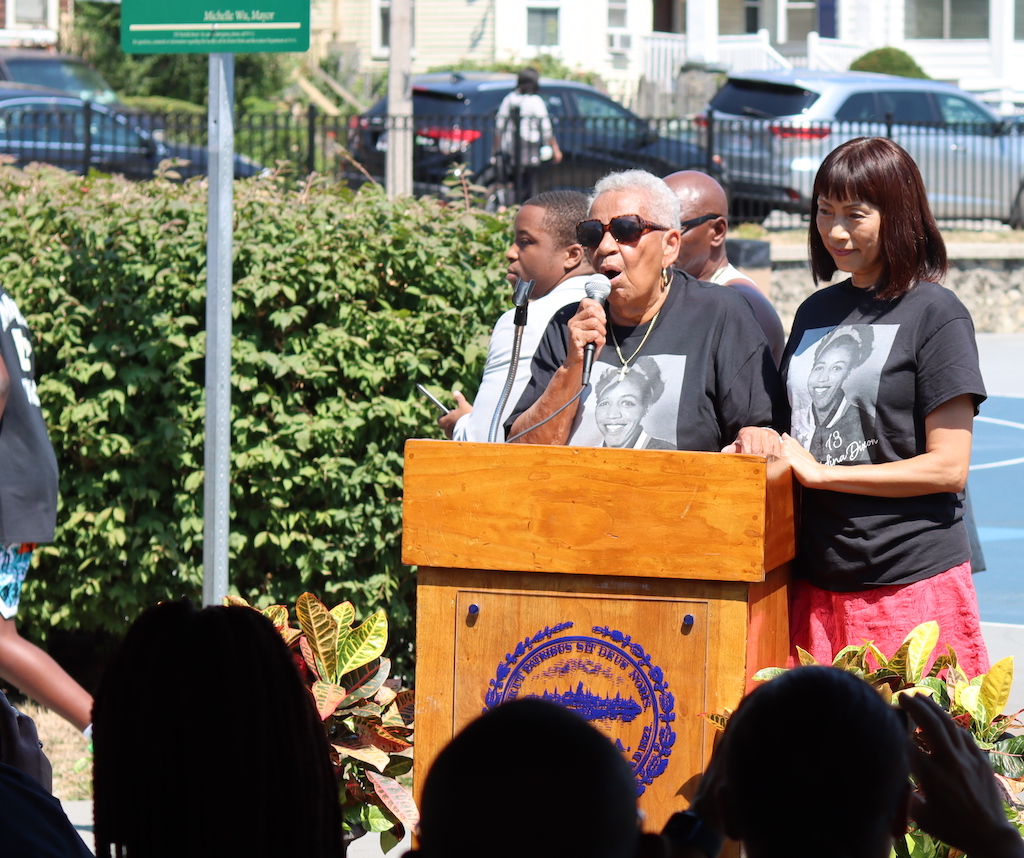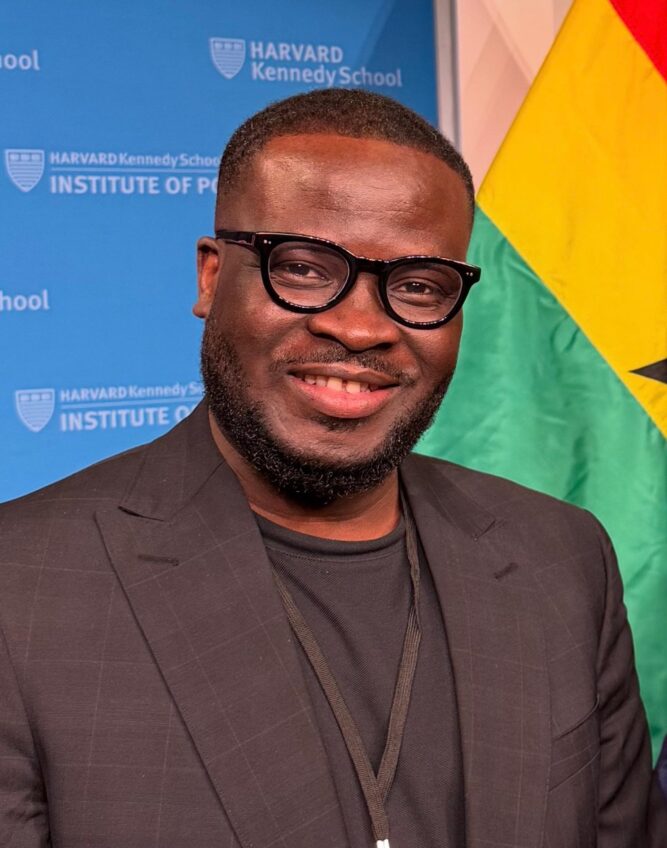
On a hot August afternoon, two girls basketball teams were running the court at Walker Playground in Mattapan — a summer basketball ritual. Coach Alfreda Ramsey Harris — Ms. Harris — looked on.
After the game, Boston’s public officials congregated nearby to dedicate the brand new courts to Medina “Ice” Dixon.
A national collegiate champion and Olympic medalist, Medina Dixon once played youth basketball for Ms. Harris’ Shelburne Smokers. Her career took place in the nascent phase of women’s basketball before the WNBA era.
Dixon’s life is a credit to the women’s basketball tradition of Ms. Harris’ home court: The John A. Shelburne Recreation Center, named for her mentor.
The center was dedicated to Shelburne on December 3, 1972. As the founding director, Ms. Harris put the key in the door.
Shelburne — a Dartmouth All-American fullback and WWI veteran — ran Roxbury youth programs at the Robert Gould Shaw House. Starting at the age of 10, Ms. Harris went daily and learned basketball in the gym — a court since 1919.
Shaw House girls played 6-on-6 basketball with limits on dribbling and moving.
“Three and three,” recalled Ms. Harris. “You would have three guards and three forwards.”
“The forwards, if they got a rebound, could only go to half court and pass the ball to the guards.”
In Roxbury, Ms. Harris’ real basketball education came playing 5-on-5 full court with the boys.
“There really wasn’t any female competition,” she added. “We learned more losing to the boys by 2 or 5, than we did by beating the girls by 30 or 40.”
In 1952, on the Girls High team, she played full court for coach Virginia Murphy.
“A few of the girls who played on the Shaw House team also played together at Girls High,” said Ms. Harris, linking these early institutions in the capital city of basketball’s home, Massachusetts.
Ms. Harris helped Girls High win the city’s annual title, the Jamboree. The team would go on to win 11 of the next 12 titles.
Like the Shaw House court, Girls High reached deep into basketball history. It was built in 1910 when Senda Berenson, the mother of women’s basketball, was still coaching at Smith College in Northampton.
As Ms. Harris graduated in 1955, women’s basketball had few prospects beyond the high school game. Initially, she worked for Liberty Mutual.
In 1965, first of Ms. Harris’ 48 years in public service, Massachusetts’ Racial Imbalance Act passed, presaging desegregation and busing. She began at Parks and Recreation, working for the Cabot Street gym.
Ever since, Ms. Harris coached girls basketball teams on the side.
In 1969, former Celtic Wayne Embry was running the Parks Department during the Boston Neighborhood Basketball League’s creation.
Thomas ‘Satch’ Sanders — a Celtic — and Coca-Cola’s Ken Hudson, the first Black NBA referee, were partners in promoting and funding the league.
Rudy Cabral, a youth worker, and future Deputy Mayor Clarence “Jeep” Jones wrote a funding proposal that won Coca-Cola’s support. Vin Costello became the first BNBL director and future Mayor Ray Flynn joined.
With the mayor, BNBL organizers planned the league, in part, to address “the racial things that were happening within the city,” said Ms. Harris.
At the time, Boston’s racial conflict was unfolding on multiple fronts. The school board had resisted full funding for Black community schools. Police rioted in Grove Hall in 1967, beating welfare mothers protesting mistreatment. In April 1968, fires burned along Blue Hill Avenue after Martin Luther King Jr. was assassinated. Mel King, protesting urban renewal and the displacement of people of color, built Tent City at the edge of the South End.
“Sport brings people together,” said Ms. Harris. For “someone riding through Boston at night, no matter where you went, you saw lights on, playgrounds, kids playing basketball.”
The second year of BNBL basketball, Ms. Harris established a girls league. They played on brand new courts in the Fenway.
“When BNBL first started they had a girls league at the Fenway,” said Ms. Harris of city basketball courts used to this day.
“Commissioner Jack Warner had [Fenway’s courts] built specifically for the girls to use.”
That same year urban renewal leveled old Shaw House buildings where Roxbury’s Hammond and Windsor Streets converge.
Urban renewal, she said, “did separate a lot of people, who — families for generations — grew up together.”
Urban renewal also demolished her family’s Sterling Street home to make way for greenery along Melnea Cass Boulevard.
But Washington Park urban renewal also built a recreation center — the Shelburne.
Leaving the building dedication in 1972, John Shelburne advised Ms. Harris as they walked to the car.
“They don’t have to like you, but they do have to respect you. And don’t be afraid to say no.”
She learned a profound lesson in Shelburne’s words and follows his advice to this day.
The Shelburne Center opened as women’s basketball was poised to grow.
In 1971, female athletic leaders created the Association for Intercollegiate Athletics for Women, akin to the all-male National Collegiate Athletics Association. The AIAW’s first championship was in March 1972. That June, Title IX protections against sex discrimination became federal law.
In the early years of Title IX, Roxbury teams dominated girls BNBL. Ms. Harris’ Shelburne Uniques and the YMCA’s Sequins only lost to each other, passing the title between them for BNBL’s first eight years.
“Washington Park was happening, the lights were on at night. It was packed, crowded, players, all kinds of players,” said Susan Summons, a Unique.
Playing alongside Summons were twins Cherie Cope and Jennifer Webb, Marcia Williams, Darlene Cox, and Carolyn Lewis. All five played for Ms. Harris at Roxbury Community College.
“Marcia was all around: defense, she could score, she could rebound,” Cope said.
Carolyn Lewis was “strong off the bounce in the block. Strong rebounder, great hands,” recalled Summons.
“It was no holds barred when we played,” said Cope, their top defender, “we were serious about playing basketball.”
“Most of my players could play in and out,” said Ms. Harris of their interchangeablility. “Back then, if you played, you played.”
A bit older than the Uniques players, some Sequins learned 6-on-6 basketball as Ms. Harris had.
Running practices at the Shelburne, Ms. Harris insisted on endurance.
Summons recalled, “You’d come in that gym for practice, lace up, and she’d say, okay, let’s get 50… 50 laps, then we go into our full court transition drills.”
“Her thing was: run,” said Cope.
“My teams, basically, always had a lot of speed and quickness,” said Ms. Harris.
“There just wasn’t anyone at that time that could take us on and match the talent, the speed,” recalled Summons.
The team was outgrowing youth basketball.
The day came when someone asked Ms. Harris, “Are any of these young ladies planning on going to college?”
She couldn’t say. Roxbury Community College’s athletic director, Willie Booker had her start the school’s junior college women’s basketball program in 1975.
That season, RCC’s all-Black Expressettes went 18-5 wearing matching orange Converse.
Alfreda Ms. Harris (standing, at right), with the 1977 Roxbury Community College team. Courtesy photo
Cherie Cope was captain. Marcia Williams, at 5-foot-8, was the top-scoring MVP, averaging 26.5 points per game, the highest in the state. Home games and practice were at the Shelburne.
“We didn’t have much,” said Ms. Harris, “but, couldn’t nobody beat us.”
The Expressettes pressed full-court to create turnovers and run the fast break.
“We would press, steal, go,” she said.
“If you can’t catch us, then we can beat you.”
“We still played fast,” said Summons. “We already had the chemistry, we already knew each other.”
“Because they had been around each other so long, they were very unified,” said Ms. Harris.
“We killed everybody in New England.”
RCC won the region 21 title, qualifying for the National Junior College Athletic Association championship in Overland Park, Kansas. Tournament MVP Marcia Williams had 19 points in the title win.
Ms. Harris told them, “Once you leave New England, it’s a brand new world.”
“Our first year was a ‘show up,’ we didn’t have the talent, really, outside of Marcia,” Cope said.
BNBL-phenom Susan Summons joined in 1976. The Expressettes went undefeated through a second regional title, 25-0.
“Susan could score, now,” said Cope of Summons, “she was a scoring machine.”
Carolyn Lewis, a 5-foot-8 forward, averaged 16 boards.
The undefeated RCC team encountered resentment at regionals in Rhode Island.
“All of a sudden our players start calling me from the court. I called a timeout, and said ‘what’s the problem?’“ Her girls told her their opponents’ play-call: “ghetto.”
“Who didn’t run the play called ‘ghetto?’” laughed Cope of futile antagonisms.
“We encountered that in ’75, more in ’76 and ’77.”
Unfazed, Ms. Harris answered, “The next time they call ghetto, you steal the ball, you go down, you make a layup, and you say ghetto. And that was the end of that.”
Regional champs in 1977, RCC won two more games in Kansas.
Then, they faced Panola Junior College. Third the year before, Panola was Texas’ basketball powerhouse. This year, Panola started a 6-foot-1 freshman, Rosie Walker.
“We were down there playing them big girls from Texas,” recalled Ms. Harris. “We lost, but it was a great experience.”
Cope remembered Walker’s height, “I thought Rosie was about 6-5.”
Walker’s skill and strength overmatched the shorter Expressettes. Panola’s guards, Lisa Hughes and Mildred Hodges — tournament MVP — set the pace.
RCC opted to front Walker in the paint to deny post-passes, ceding space to the basket.
“Our tallest player at that time was Harriet [Wilkins],” said Cope.
“Harriet was 5-11, very raw. Under her was my sister Jennifer, Jennifer was 5-9,” Cope said.
Neither could stop Walker. Nor could Carmen Green, a 5-9 beauty queen.
Panola won 81-67, then beat Seminole State College — victors from 1976 — by one point for the title.
Susan Summons was named to the All-Tournament Team.
Massachusetts Governor Michael Dukakis declared April 8, 1977 as RCC Day.
Finishing an NJCAA All-American season, Marcia Williams drew college recruiters’ attention.
“We were taking Marcia Williams down to visit Savannah State. Girls were playing. Nothing serious, just pickup,” recalled Ms. Harris.
Shebra Legrant, at 5-foot-10, from Vidalia, Georgia impressed the Bostonians, who convinced her to visit RCC.
Ultimately, both Williams and Cope went to Cheyney University to play for coach Vivian Stringer.
For 1977, Shebra Legrant joined the Expressettes.
Ms. Harris and Cherie Cope remember her as “strong as an ox.”
That season, RCC began athletic scholarships for sophomores. Freshman Shebra Legrant averaged 32 points and 22 rebounds.
Legrant “was a beast in that era for women’s basketball,” said Summons.
“Big hands, long arShe could hang on the rim.”
Shelburne Director Diane Galloway, once an Expressette, said, “Shebra was… she was different.”
At the Shelburne, a young girl destined for the WNBA, Michelle Edwards, watched in awe.
“She was really good at rebounding outside of her area,” said Edwards, “just would not be denied and was mean!”
“I don’t know if she ever got the ball stolen. If you did steal, you probably lost a couple teeth.”
“We dominated straight through to another Massachusetts junior college state championship and a national junior college tournament,” said Summons.
In New England, Summons was MVP; Ms. Harris, coach of the year.
Back in Kansas for the 1978 tournament, the Expressettes played Panola in their second tournament contest.
Rosie Walker returned with 5-10 All-American Peggy Pope in the backcourt.
Panola beat RCC and won the title. Both Legrant and Summons were All-Tournament Team honorable mentions.
Summons played professionally in the Women’s Basketball League, and later coached RCC’s 1988 state champions. In 2013, she and Ms. Harris were inducted into the NJCAA Women’s Basketball Coaches Association Hall of Fame.
In Ms. Harris’ final season at RCC, the Expressettes once again qualified for nationals — the fourth straight year in the tournament. They finished 6th. Legrant earned All-Tournament honors alongside a teammate recruited from Florida earlier that year, Cynthia “Cricket” Samuels.
In 1980, finishing junior college, Legrant was recruited by University of Kansas coach Marian Washington, who had seen her at the tournament.
Washington’s top player that year was Lynette Woodard, a 6-foot forward and women’s basketball legend.
Woodard scored 1,177 points with 545 rebounds during the 1980 season.
Kansas went 29-8 in 1981, with Shebra Legrant shooting .631 from the floor and averaging a double-double.
Both had high scoring college careers before NCAA records began. Legrant surpassed 1,000 points in only two years. Woodard’s 3,649 points are better than anyone since.
After college, Woodard would have been a top WBL draft pick, if only the league didn’t fold in 1981. While Europe had professional teams, she joined the Harlem Globetrotters in 1985.
In July 1981, Ms. Harris held a basketball camp at UMass Boston shortly after launching its women’s team. As a measure of her standing, Woodard showed up to work as a counselor.
That summer, a block from where the Shaw House once stood, Woodard and Legrant went looking for a basketball game.
“I was with Ms. Harris and we went to Derby Park and played with the boys,” recalled Edwards of Ramsay park, now named for a Black Vietnam veteran.
“Dropping the ball in the rim,” said Edwards, Woodard “was just killer. Shebra was doing her thing and I was on the court with them.”
A year into Cathedral High School, Edwards eventually scored 2,121 points — the first player over that millennial milestone in Massachusetts. In 1997, she would suit up with the WNBA’s Cleveland Rockers as Lynette Woodard’s teammate.
But first, Edwards played for Ms. Harris’ renowned Shelburne Smokers travel team.
Over the course of many years, future Division I stars played for the Smokers: Robin Christian, Antonia “Shorty” Macklin, Tonya Cardoza, Crystal Flint, Averrill Roberts, and Brandy Cruthird.
But, of all the Smokers who played for Ms. Harris, Medina Dixon was the best.
Growing up with 11 siblings in her family’s Willowwood Street home, she played — and beat — the boys.
Sitting by his sister’s court, Herb Dixon recalled how Medina “would go behind the back on you, pull-up and hit it.”
“She was like poetry in motion,” said Edwards of the 6-foot-3 Dixon.
Edwards recalled Dixon’s “tall slender frame” and that she “could handle the ball like a guard.”
“She was a scorer, a rebounder. She would tap the glass,” Edwards reminisced, “she played like a guy. But, you know, was a girl. And I loved that.”
At Cambridge Rindge and Latin senior year, Medina Dixon led her team to a state championship.
Off to college, Dixon bestowed her nickname, “Ice,” upon her younger teammate, Michelle Edwards, saying “‘Big Ice’ has got to go on to do bigger and better things.”
Soon, she did: becoming the women’s basketball top scoring Olympian in 1992.
After battling pancreatic cancer, Medina Dixon died on Nov. 8, 2021.
At the court dedication, Ms. Harris rued the delayed recognition of the talented Boston hoopster as she surveyed reporters and photographers from outlets that had ignored her whole career.
“They had nothing on her,” said Ms. Harris.






